Last week, during the 100 degree NYC heatwave, I popped over to the library to kill some time. [Side note: who else, when they hear the phrase “killing time” thinks about Tock from Phantom Tollbooth sobbing, “It’s bad enough wasting time without killing it”? ] I came across a gorgeous large-format book by French author-illustrator Benjamin Chaud called Little Bear’s Big House (2018).
In the story, a precocious little bear wanders into a house in the woods. Halfway through, Chaud gives us this showstopper: A cross section of the house so big and so detailed that your eye can slowly wander from room to room. (The book’s dimensions are 9″ x 14″ so it’s truly immersive.)
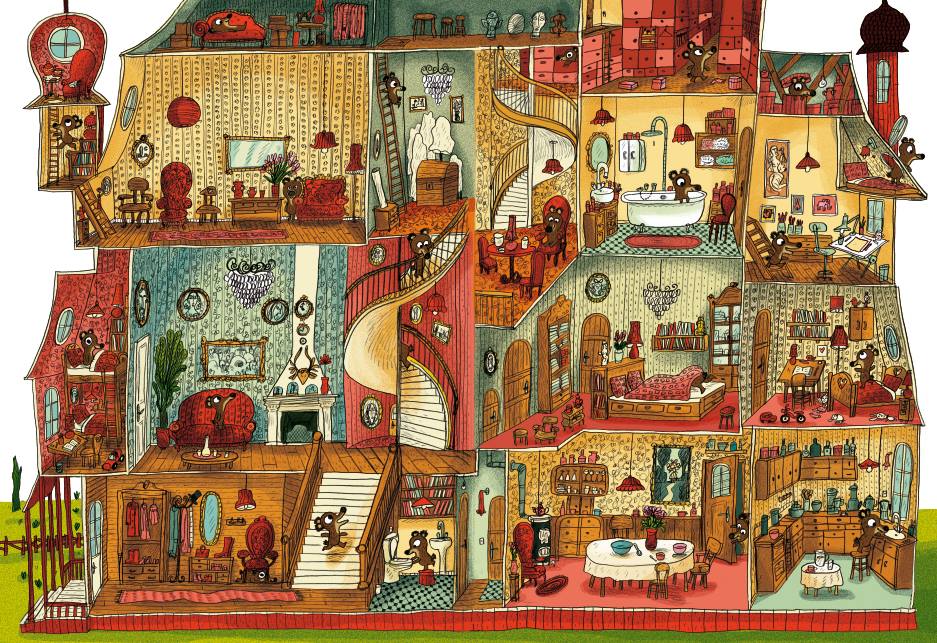
I posted a pic on Instagram and immediately got tons of comments from other picture book fans reminiscing about other cross-sections in picture books. There’s something completely captivating about these illustrations: They’re the 2D version of playing with dollhouses, simultaneously instilling in the reader a sense of wonder and also a sense of god-like mastery.
To start, there are the Richard Scarry classics. For many kids, these cutaway views of Busytown are the first cross-section pictures they ever see. The labeled illustrations are perfect for an adult reading with a child, making each moment something to talk about. At the same time, Scarry makes sure there’s something funny to laugh about with each vignette, so the pictures are not simply didactic.
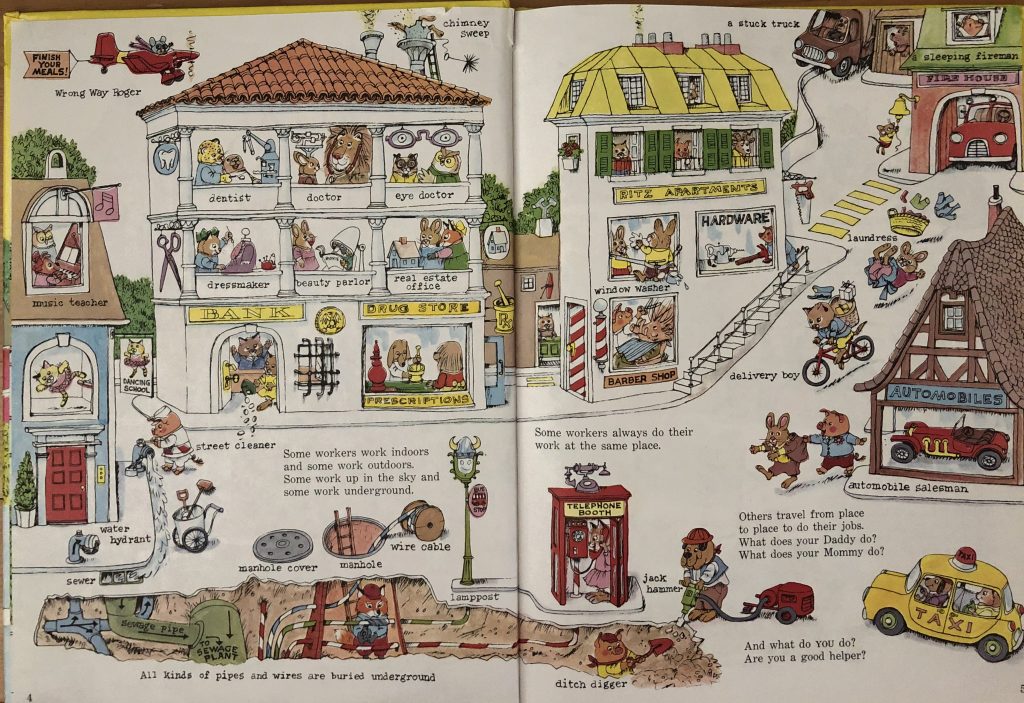
The other author that probably comes to mind with these sorts of illustrations is David Macaulay. The How Things Work author is legendary for the clarity of his explanations and the precision of his architectural and mechanical drawings. This is from Castle (1977):
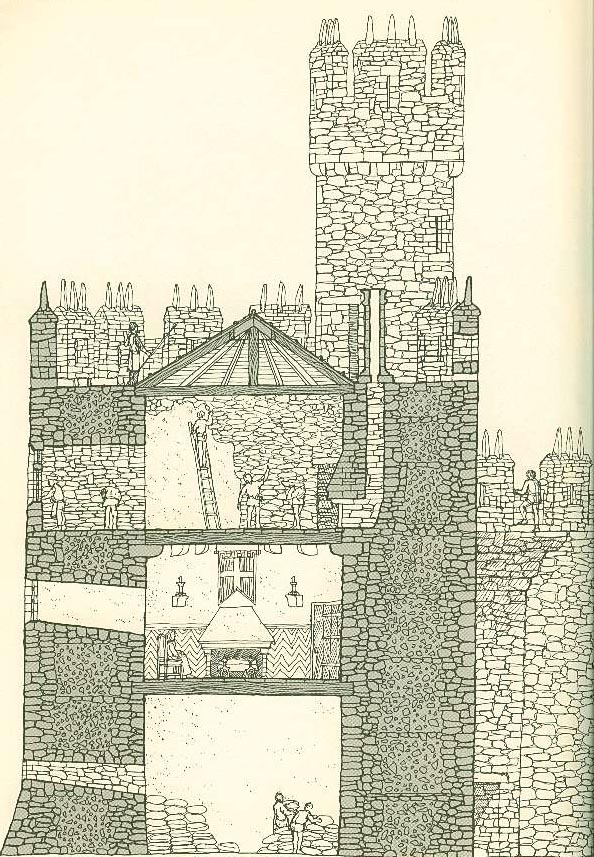
In the UK, the writer-illustrator Stephen Biesty has single-handedly dominated the field of technical cross-sections with his Incredible Cross-Section series for Dorling Kindersley. He’s very influenced by Stephen Macaulay and the 1950s English illustrator Leslie Ashwell Wood.
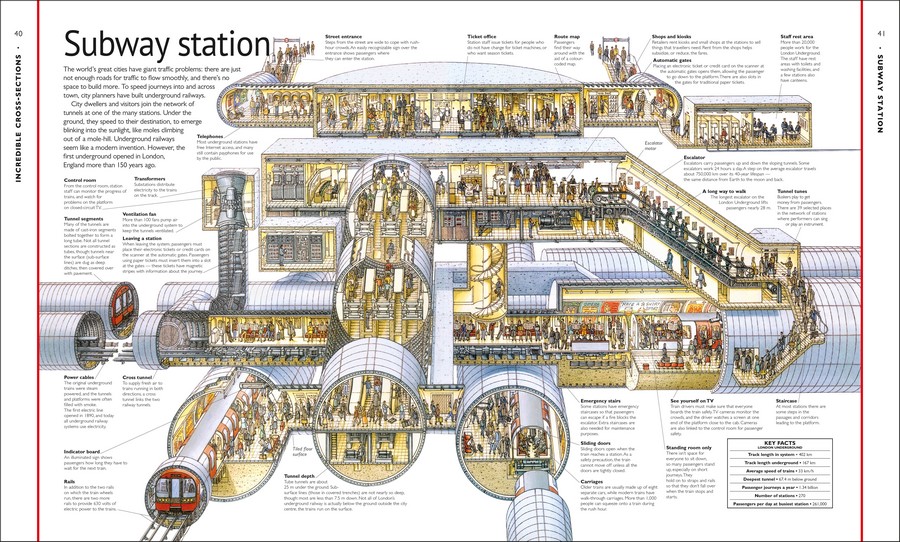
While Biesty and Macauley’s illustrations explicate hidden mechanisms in the real world, my personal preference has always learned toward the fictional.
For instance, here’s Gyo Fujikawa’s take on the Old Woman Who Lived in a Shoe (featuring the Old Woman whaling each poor kid on their way inside—how amazing is this?!) :

There is also the lesser-known Babar book, Babar and Father Christmas (1940), one of the last written by Jean de Brunhoff. In this one, readers get a glimpse of Father Christmas’s house, including “the doll room, the soldier room, the train room … dwarfs’ dormitories, the lifts and the machine-rooms.”
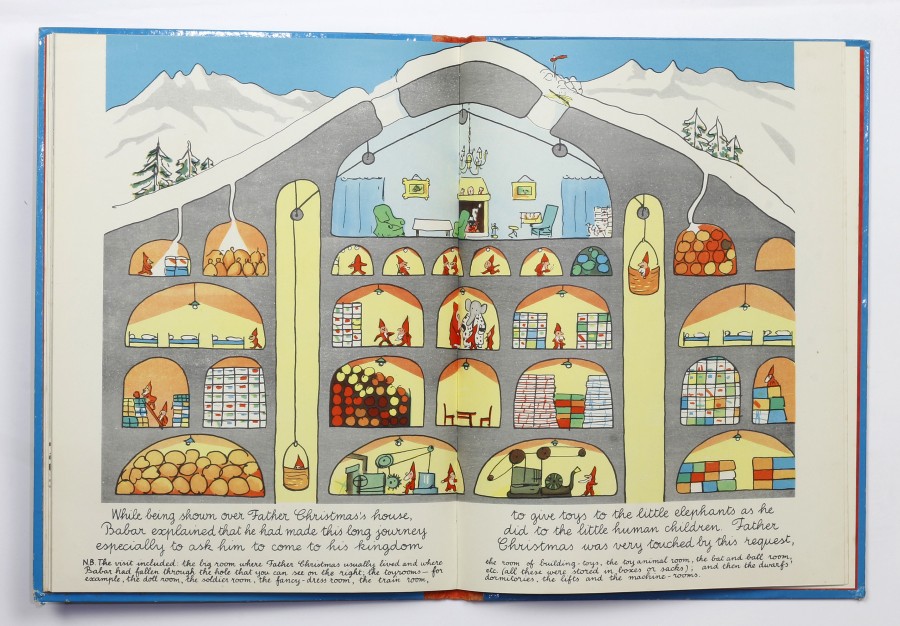
Are you familiar with The Big Green Book by Robert Graves, illustrated by none other than Maurice Sendak? I have to admit, I was not. It’s about a little boy who discovers a book of magic in the attic and learns all sorts of spells:
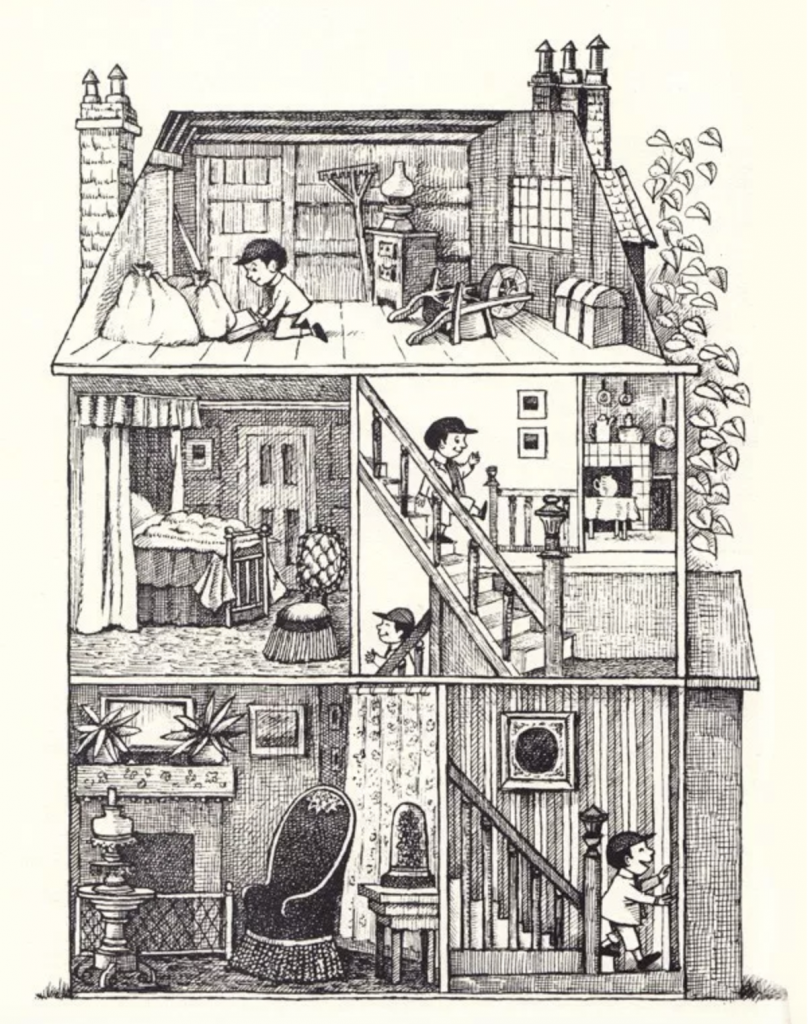
And here’s the inside of Pippi Longstocking’s house, as imagined by Dutch illustrator Carl Nicolaas Hollander (1934-1995):
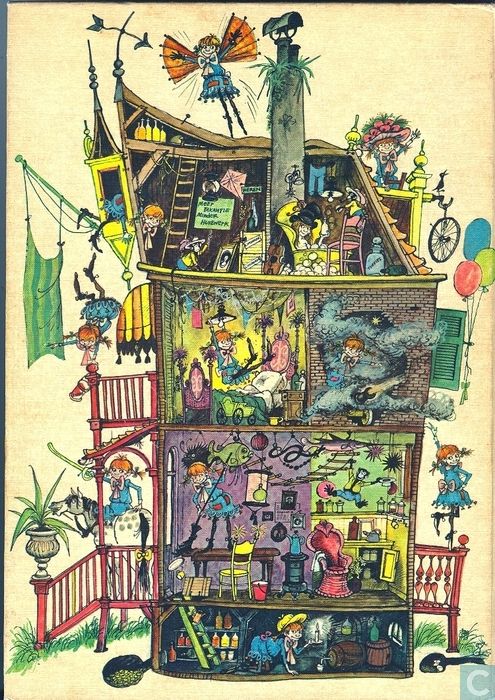
One series I learned about from a commenter on Instagram is the Brambly Hedge series by British author Jill Barklem. (The first in the series, Spring Story, came out in 1980.) The stories follow the adventures of a community of mice who live in the English countryside — the illustrations are very much in the tradition of Beatrix Potter and include some delightful cross-sections of the cozy mouse houses:
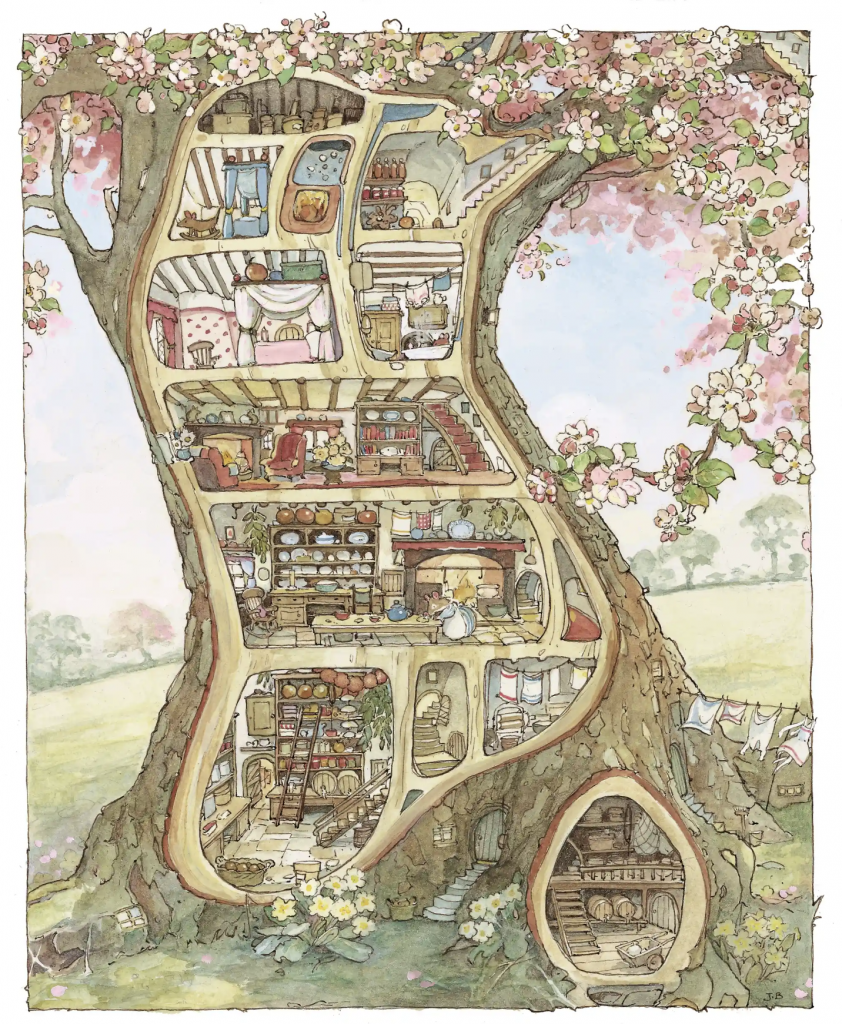
Not surprisingly, mice lend themselves well to these sorts of illustrations. When my daughter was little we loved reading Mary and The Mouse, the Mouse and Mary by Beverly Donofrio (2007). The illustrations by Barbara McClintock depict the parallel worlds of humans and mice, with the mice living directly beneath the floorboards of the family’s chic midcentury home:
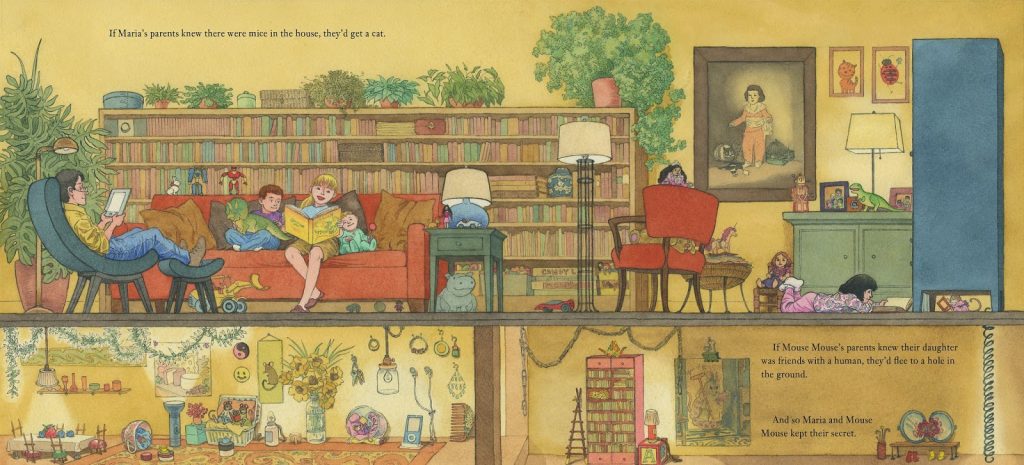
One of my all-time favorite writers and illustrators is William Pène du Bois, who gave us Twenty-One Balloons and William’s Doll. He wrote a book called The Three Policemen (I wrote about it previously here) which is totally charming but nothing all that special, except for the end pages which are unforgettable. They feature the cross-section of a fantastical ship designed to look like a sea serpent:
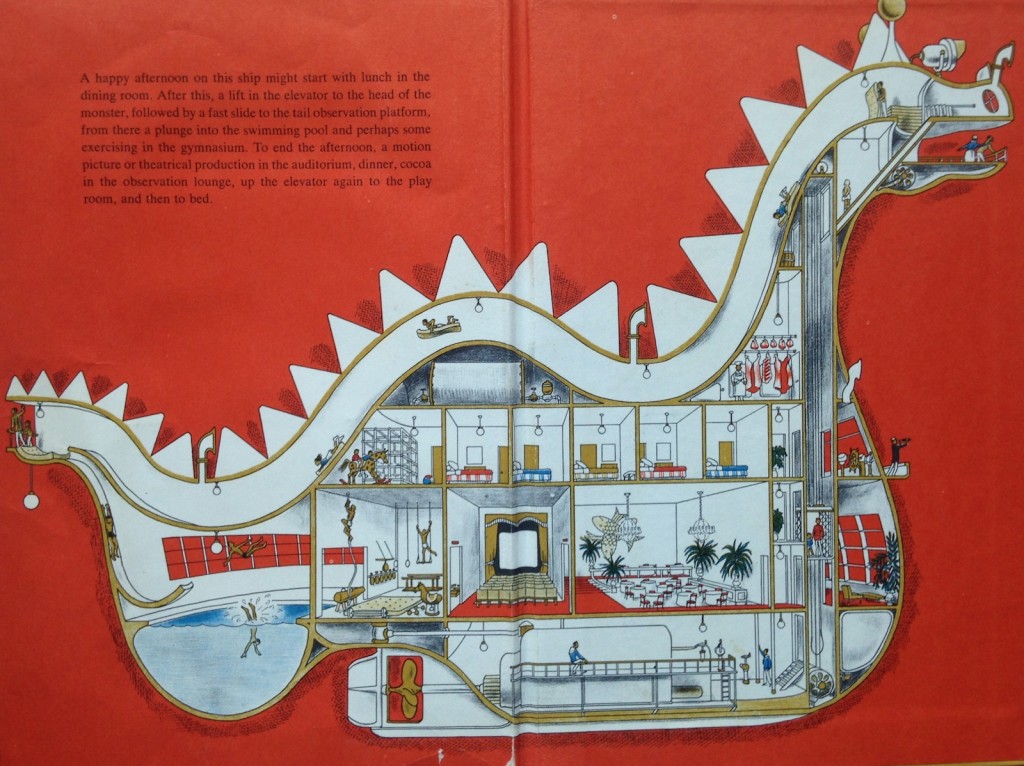
Here’s a book I learned about from interior designer Mara Miller, when I interviewed her for a story about designers’ favorite children’s books. It’s called The Fourteen Bears in Summer and Winter by Evelyn Scott (sadly, it’s out of print) and features the stylish homes of bears:
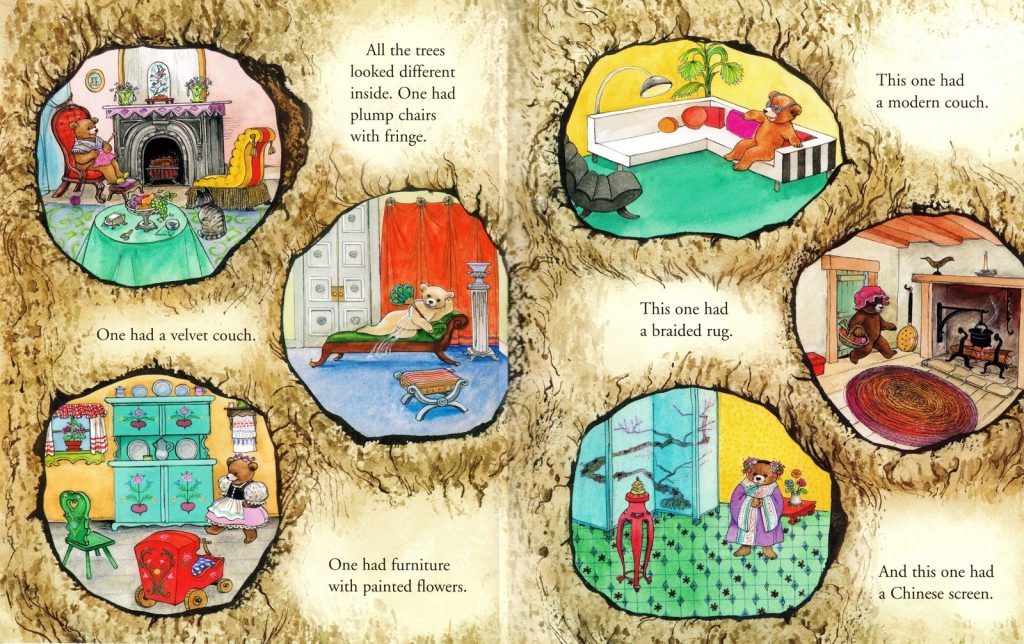
Speaking of bears, I am not a big fan of the Berenstain Bears. But this cross-section of their treehouse is pretty darn fun (note the basement Ping-Pong table):
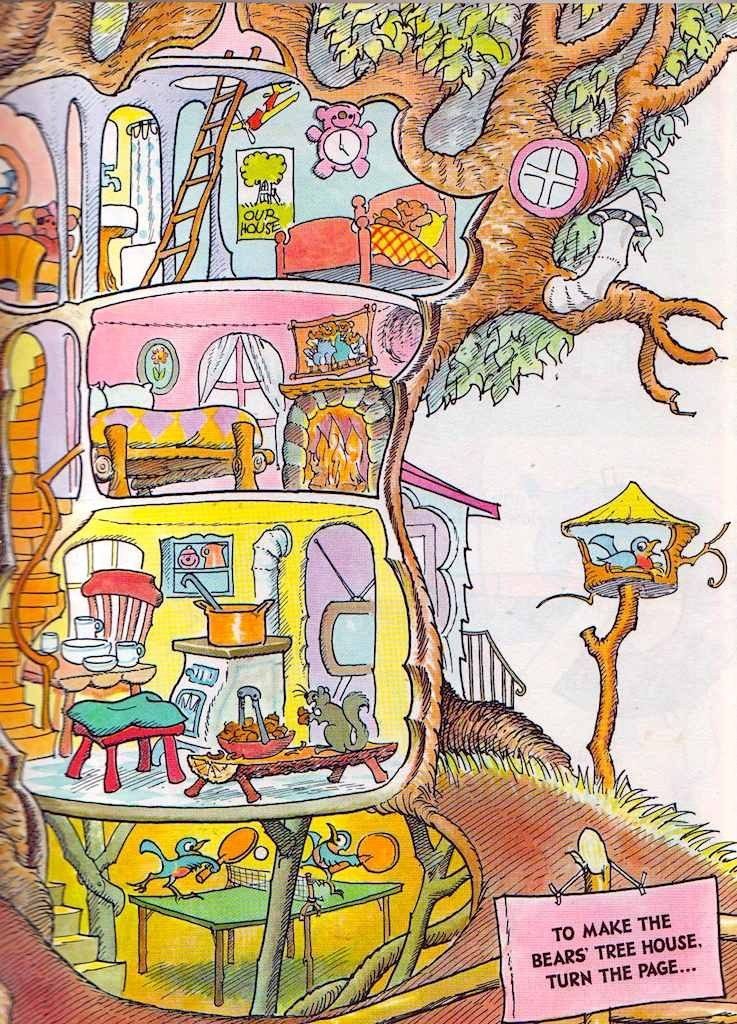
I am very fond of the illustrations of Japanese author Mitsumasa Anno. (Incidentally, Anno is still alive and is 93 years old!). This is from Anno’s Counting Book (1975):
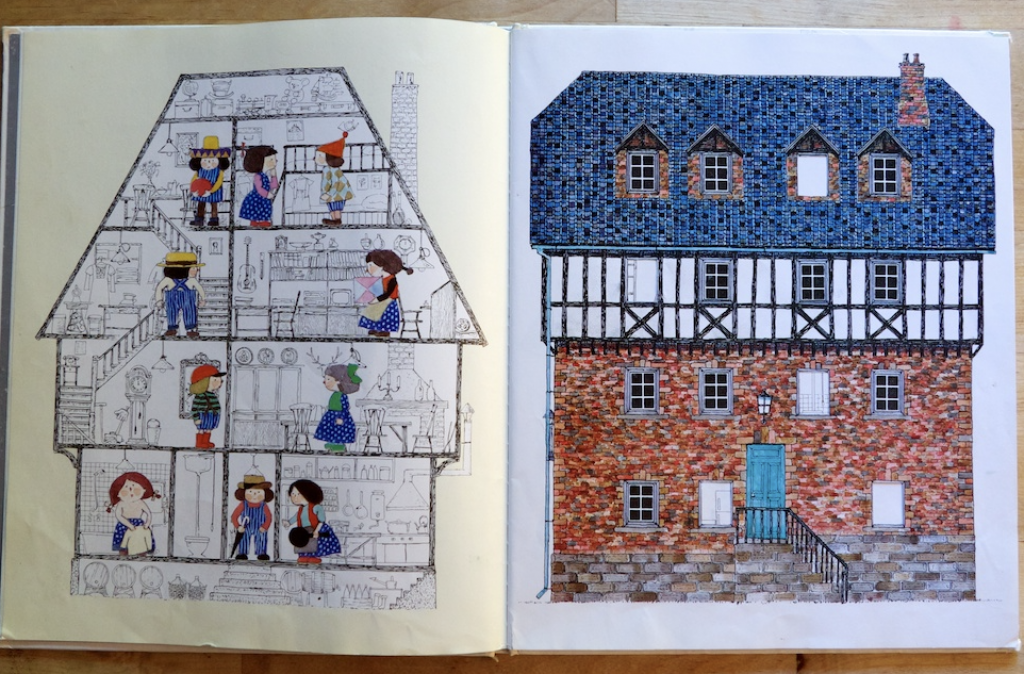
What else? Do you like gnomes?
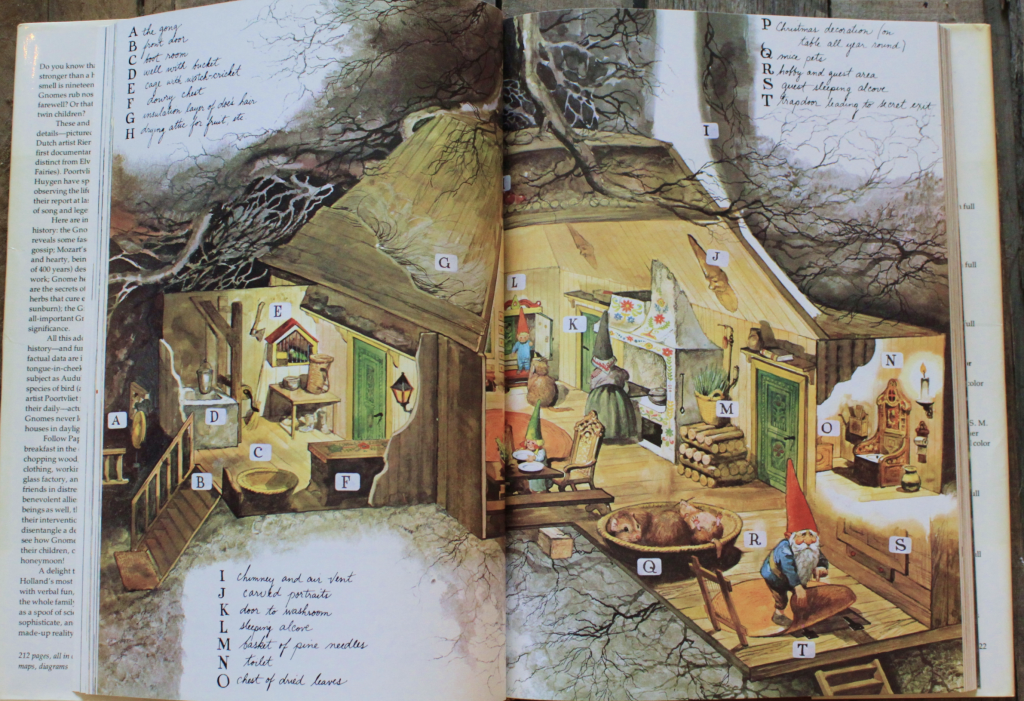
There’s also the wordless book Full Moon Soup by Alistair Graham (2007), which is set in a baroque Fawlty Towers-type of hotel. It feels like The Sims!

Sophie Blackall can do no wrong, in my opinion. Hello, Lighthouse (winner of the 2019 Caldecott) has this image of the interior of a lighthouse that feels absolutely perfect in every way, from the sage green interior walls to that tidy bed with single pillow.
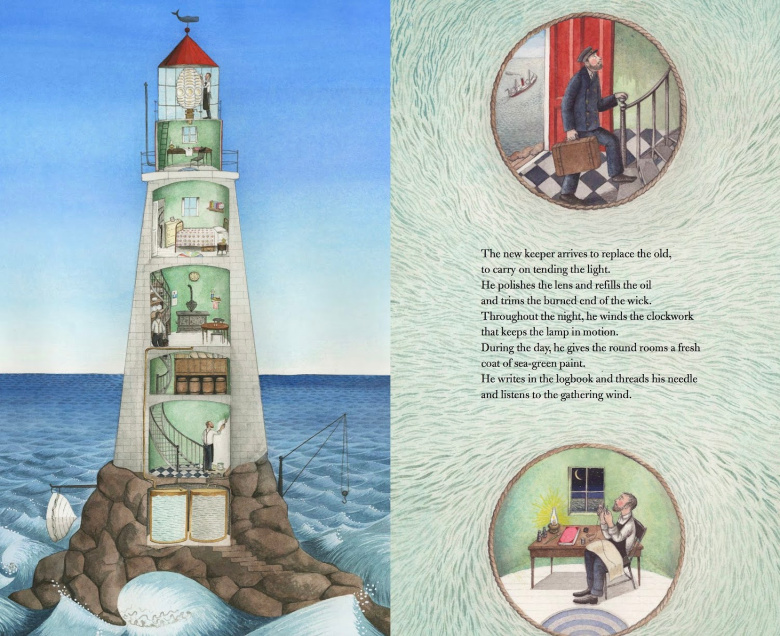
And now I will just leave you with this final cross-section, from David Macauley’s Toilet:
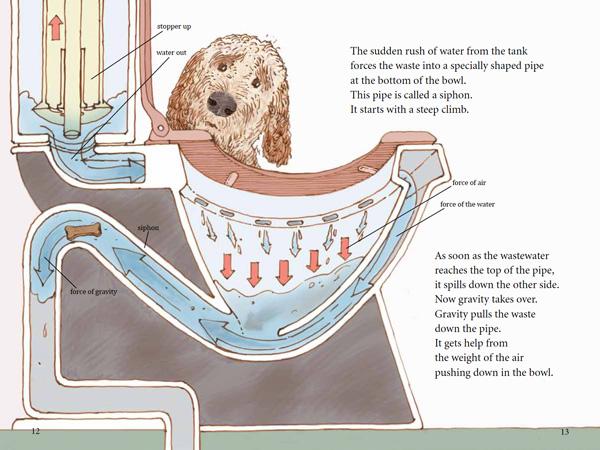
What good ones have I missed? Please tell me in the comments here or over on my Instagram @mrslittlebooks
Thanks for reading!

In the town All year round has some amazing cross sections, too. Great round-up here!
Came here to recommend this – love this book! Still finding new things four years after buying it for my oldest.
Also Mouse Mansion – a real doll house (village, really) made for mice, with a story to accompany each vignette.
You’ve missed my favorite: “where’s wallace?” By Hilary Knight! His “Twelve Days of Christmas” is also fantastic for cutaways.
I had no idea. I love Hilary Knight of course. Never saw this book! I hope its not out of print, I’m going to look for it right now.
The mouse ballet theatre at the end of Angelina Ballerina! One of my favorites from when I was little. As soon as I read the name of your post, I thought for sure it would be on the list!
This I have not seen! My kids didn’t read Angelina and so its one of those beloved books I totally missed! It will have to go into my second roundup of cross-sections. Thank you Blythe!
One of my favourite books as a child was Need a House, Call Ms. Mouse by George Mendoza. It features a mouse who is an architect as she tours the various houses she designed for other animals (squirrels, cat, fox, spider, pig, etc). Thankfully my parents kept the book so I can still enjoy it with my children.
Oh man, I’ve been trying to get a copy of this for YEARS. it’s so rare! i have only seen a couple of images. But from what I’ve heard, I think I would love it.
I got a copy for 2$ in a bazaar. I was literally shaking when I found it!!! Felt like a thief!
I had borrowed this book about 100 times from the library when I was a kid.
Lovely list, thank you for the nice discoveries!!!
Need a House…will be reissued in June 2023
Also, Trouble for Trumpets, the most delightful book I had as a child! https://petercrossart.com/books/trumpets/trouble-for-trumpets
OOOOh so good. I had never heard of it! Thank you for this — I need to do a second round of cross-sections!
Several additions come to mind: ‘The Troll Book’ by Michael Berenstain has a fantastic cross-section of the main troll castle (http://www.vintagechildrensbooksmykidloves.com/2013/01/the-troll-book.html).
Also, both ‘The Haunted Castle’ and ‘The Apartment Book’ by Leo Hartas feature incredibly detailed cross-sections throughout (http://www.hartas.eclipse.co.uk/Haunted_Castle_Details.html) (https://www.amazon.com/Apartment-Book-Leo-Hartas/dp/0789401975).
Great idea for a post!
COOL! Thank you Ben! I don’t think I know about any of these!
Hi.
I was wondering if y’all can help me. I’m looking for the title of a illustrated children’s book. It contains a cross section of a house and focuses on three generations of a family. It mainly focuses on the grandfather, the father, and the son. The theme is generational changes and how baseball connected each generation. It was written either in the 80s or 90s. Thank you for your time.
Pingback: Make: Mix and Match DIY Haunted Houses - barley & birch
This was one I remembered reading as a kid.
“Ruby” by Colin Thompson
https://books.google.com/books?id=d14NtkvUz54C&printsec=frontcover#v=onepage&q&f=false
Great List! I dont know why more illustrators dont do them. A few of my favorites. Andrew Henrys Meadow by Doris Burn- she has several other books with wonderful cross sections as well. Britta Techentrup has a book called Busy Bunny Days its all cross sectioned and one of my favorites to read with my kiddos. She features cross sections of a town where the family lives, farm where they holiday, and port. I dont know that the port includes cross sections. Its similar to In The Town All Year Round only rather than seasons shows times of day. Lots to look at though.
Had a favorite book of animal home cross sections as a kid where the animal families were all going to bed for the night. Just can’t remember the title anymore!!
Same!! I’m here looking for the same book as you, I bet. I’ve never seen it since childhood, it was completely memorable, except the title. A beautiful book , I’d love to find it again.
I am pretty sure am looking for the same book…
Tony Auth’s Sleeping Babies!
Oh my god, this is it!!! I have been thinking about this book for years. Thank you thank you thank you!
Pingback: Faire: une maison hantée de bricolage à mélanger et à assortir – mes emplois préférés
The dog that dug!
Hi, I love this, so many great examples! I’d like to add that the illustration with the gnomes you shared is by Dutch illustrator Rien Poortvliet.
Toby Auth’s Sleeping Babies is almost all animal house cross sections!
never heard of that book! But i see used copies online and I will explore Sleeping Babies. Thank you Katherine!!!
Thank you so much for this! If you’re still looking for recommendations, french illustrator Claude Ponti has some amazing cross section illustrations in his books, especially My Valley.